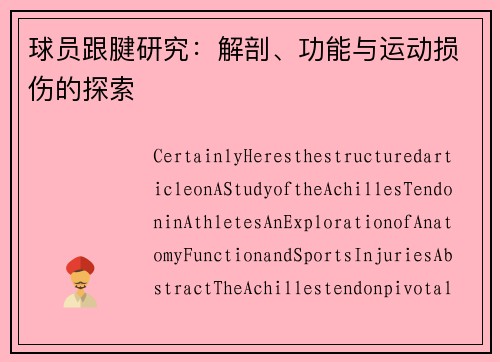球员跟腱研究:解剖、功能与运动损伤的探索
Certainly! Here's the structured article on "A Study of the Achilles Tendon in Athletes: An Exploration of Anatomy, Function, and Sports Injuries".
**Abstract:**
The Achilles tendon, pivotal in athletic performance, undergoes intense scrutiny due to its critical role in movement and its susceptibility to injury. This article explores its anatomy, biomechanics, the impact of sports activities on its health, and potential strategies for injury prevention and treatment.
1、Anatomy of the Achilles Tendon
The Achilles tendon, the largest and strongest tendon in the human body, connects the calf muscles to the heel bone. Its structure comprises primarily collagen fibers, organized to withstand immense tensile forces.
This segment will delve into the microscopic anatomy, detailing its composition and arrangement of fibers that facilitate its role in transmitting forces during movement.
The blood supply and nerve innervation of the Achilles tendon will also be discussed, highlighting their importance in its function and susceptibility to injury.
2、Biomechanical Function of the Achilles Tendon
The Achilles tendon plays a crucial role in various movements, including walking, running, and jumping. Its biomechanical properties enable efficient energy storage and release, contributing significantly to athletic performance.
This section will explore how the tendon functions as a spring-like mechanism, storing elastic energy during dorsiflexion and releasing it during push-off phases of gait.
The influence of tendon length and stiffness on performance will also be examined, emphasizing its dynamic role in optimizing movement efficiency.
3、Sports-Related Injuries of the Achilles Tendon
Athletes frequently experience Achilles tendon injuries, ranging from acute ruptures to chronic overuse conditions. Understanding the mechanisms and risk factors associated with these injuries is crucial for prevention and treatment.
This part will discuss common sports-related injuries such as Achilles tendinopathy and tendon ruptures, exploring factors like training errors, biomechanical imbalances, and anatomical variations that predispose athletes to these conditions.

Diagnostic approaches and rehabilitation strategies tailored to different types of Achilles tendon injuries will also be addressed.
4、Conclusion: Implications for Research and Practice
The study of the Achilles tendon continues to evolve, driven by advancements in anatomy, biomechanics, and clinical research. Insights gained from this exploration have significant implications for both athletic performance enhancement and injury prevention.
This final section summarizes key findings, emphasizing the importance of a multidisciplinary approach to address the complexities of Achilles tendon health in athletes.
Overall, the Achilles tendon remains a focal point of research due to its pivotal role in athletic performance and susceptibility to injury. By comprehensively understanding its anatomy, biomechanics, and response to sports-related stress, researchers and practitioners can better support athletes in achieving optimal performance while mitigating the risk of tendon injuries.
Galaxy银河国际官网As research progresses, integrating findings into training programs and injury management protocols will continue to enhance athletic outcomes and overall tendon health.